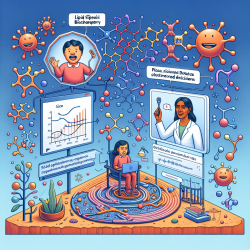Introduction
In the realm of online therapy services, particularly those focused on children, the integration of cutting-edge research can significantly enhance therapeutic outcomes. One such area of research is lipid biochemistry, as explored in the article "My Journey in Academia as a Lipid Biochemist" by Dr. Viswanathan Natarajan. While lipid biochemistry might seem distant from speech therapy, the methodologies and insights from this field can offer valuable lessons for practitioners in making data-driven decisions and improving therapy outcomes.
Understanding the Research
Dr. Natarajan's extensive research over nearly five decades has focused on the role of sphingolipids and their metabolizing enzymes in various cell types under both normal and pathological conditions. His work has identified potential therapeutic targets that could ameliorate conditions like pulmonary fibrosis and bronchopulmonary dysplasia. By utilizing OMICS technologies, his research aims to unravel the complex roles of lipid mediators in cellular functions.
Application to Speech Therapy
While the direct application of lipid biochemistry to speech therapy may not be immediately apparent, there are several key takeaways that can be translated into practice:
- Data-Driven Approaches: Just as Dr. Natarajan uses data to identify therapeutic targets, speech therapists can leverage data analytics to tailor interventions to individual needs, track progress, and adjust strategies accordingly.
- Interdisciplinary Collaboration: The collaborative nature of Dr. Natarajan's work highlights the importance of interdisciplinary approaches. Speech therapists can benefit from collaborating with other healthcare professionals to provide comprehensive care.
- Innovative Methodologies: The use of advanced technologies and methodologies in lipid research can inspire speech therapists to adopt innovative tools and techniques, such as virtual reality or AI-driven assessments, to enhance therapy delivery.
Encouraging Further Research
Dr. Natarajan's journey underscores the importance of continuous learning and research. Speech therapists are encouraged to engage in research activities to explore new therapeutic techniques and validate existing practices. By staying informed about the latest scientific advancements, therapists can ensure that their methods are both effective and evidence-based.
Conclusion
The intersection of lipid biochemistry and speech therapy may not be immediately obvious, but the principles of data-driven decision-making, interdisciplinary collaboration, and innovation are universally applicable. By integrating these principles, online therapy services like TinyEYE can enhance their offerings and improve outcomes for children.
To read the original research paper, please follow this link: My Journey in Academia as a Lipid Biochemist.










